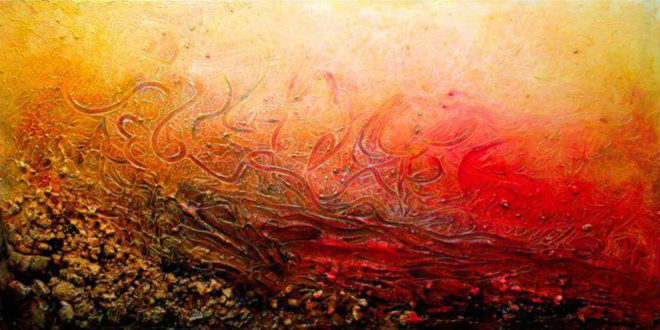-
T.S. Eliot’s “The Love Song of J. Alfred Prufrock” was the poem that made me decide to become an English Major.
J. Alfred Prufrock is characterized as a nebbish man who despairs his aging and his inability to act on his desires. His social and sexual anxieties paralyze him at the point of romantic connection. He fears being laughed at or, worse yet, being misunderstood.
The poem is a long, winding stream-of-consciousness monologue where Prufrock talks himself out of taking a risk. The painting is based on the final lines:
I have heard the mermaids singing, each to each.
I do not think that they will sing to me.
I have seen them riding seaward on the waves
Combing the white hair of the waves blown back
When the wind blows the water white and black.We have lingered in the chambers of the sea
By sea-girls wreathed with seaweed red and brown
Till human voices wake us, and we drown.Moving from black and white waves down to the “chambers of the sea” describes a vertical descent into a Dantesque hell of alienation. The world is curiously silent underwater. It is a very isolating experience, though peaceful for some.
As Sartre, said: “Hell is other people.” We are only in pain at our loneliness inasmuch as we are aware of how much we want other people.
The painting is reminiscent of a fireplace, with suggested red and brown swirls to indicate seaweed or mermaid tresses. The lighting is the sort of luminescent lighting one sees when underwater. It’s peaceful… and yet not.
Mixed Media (pigment, marble and clay dust, paste, glazes) on canvas, 24″ x 48″
2009
Located at: The Beaumont Studios


A beautiful work, which I discovered quite by accident while
searching for the final line of the poem.
Midway through the canvas there is a series of marks,
which I first took as a kind of hieroglyphics, as though
symbolizing man’s early attempts at communication,
“human voices”… but then they started to assume
shapes… the silhouette of a head, for example…
at that point I stopped myself from seeing things that
aren’t there, one of my pet peeves about people
looking at abstract art!
Discovering new art and artists is one of the few
good things about the randomness of the internet!
Thank you! Want to know the truth? I was merely
trying to figure out some texture and paint colours.
I was trying to make it more interesting to myself
by tying it to a favourite poem. I also wanted to
answer the question, “How hard is it to make an
abstract painting?”
Truth is: not very hard. People will do the work
of making it seem a lot more brilliant than it is.
Maybe that’s the secret.
Prufrock is everyman.